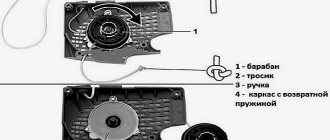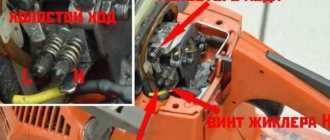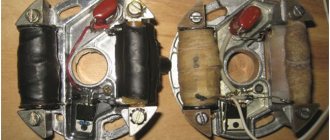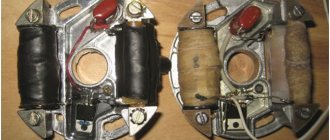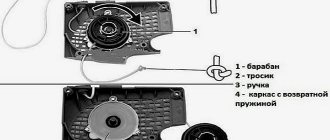Timely ignition of fuel in the internal combustion chamber underlies the operation of any gasoline engine, and a system of several components is responsible for ignition. A high-voltage pulse is formed during the coordinated interaction of all ignition elements and even their minimal defect has a negative effect on the functioning of the tool. In this article you will learn how the ignition system of modern chainsaws works, what to do if it breaks down, where to look and how to troubleshoot problems. Step-by-step photo instructions and visual videos are included.
Design and principle of operation of the ignition system of a household chainsaw
Any saw that runs on an internal combustion engine must be equipped with an ignition system. The main function of this unit is to timely ignite the fuel inside the cylinder. To do this, the chainsaw’s ignition system produces an electronic discharge that pierces the space between the electrodes of the standard spark plugs. The correctness and efficiency of the engine’s operation almost entirely depends on the serviceability of this chainsaw unit. In this regard, increased attention must be paid to checking this fundamental part of the instrument.
Electric ignition
The standard configuration of a household chainsaw consists of a number of the following parts:
- magneto;
- spark plugs;
- buttons that turn off the motor;
- wiring connecting the elements to each other.
A magneto is a separate type of generator that operates with alternating current. When working, it makes electronic energy and directs it to the chainsaw's spark plug. A coil enters the magneto device
inductance on which the stationary winding is wound. Also included in the design of the element is a permanent magnet, which is mounted on the flywheel. When the chainsaw is operating, the flywheel rotates directly with the engine crankshaft.
At the appropriate moment, a certain standard part of the device separates the existing contacts. This leads to a sharp increase in voltage and a spark between the electrodes of the factory spark plug.
With all this, the risk of contact overheating increases. To eliminate this, as well as oxidation of the wiring, the electronic circuit of the standard ignition system is equipped with a capacitor.
The ignition circuit of a household chainsaw equipped with a contactless base magneto is based on the action of a control coil. It functions as a voltage flow regulator. The electrical unit of such an ignition system is supplemented with a capacitor, a diode and a thyristor. The latter is needed to pass current with certain voltage parameters. When the thyristor opens, the capacitor begins to discharge, thereby creating a current inside the turns of the base primary winding.
After which the current is converted into a high-voltage constant voltage, which causes a breakdown in the standard spark plug located in the cylinder. The standard electronic network of a chainsaw operates on the impulse principle immediately with the forward, repetitive movements of the motor cylinder and the rotation of the crankshaft.
Starter device
Often, chainsaw manufacturers equip their units with starters that work on almost the same principle, namely: in a groove in the saw body there is a handle through which the cord is passed. When the handle is suddenly lifted, the cord is also pulled out, which engages the ratchet drum. Thus, a drum with spokes, which is located on the shaft, is activated. At this time, the crankshaft makes several revolutions, leading to compression of the fuel mixture, which at this moment is between the cylinder head and the piston. When the handle is lowered, on the contrary, the ratchet and the pins lose their contact, which leads to the shaft stopping.
As the power of the chainsaw increases, the amount of fuel mixture increases, which must ignite when the chainsaw is started. In this case, to start the engine, it is necessary to increase the number of pulls on the starter cord. To speed up the return of the drum mechanism, manufacturers use a special steel starter return spring, which has excellent elasticity.
If the spring breaks, you must: remove the mechanism cage, pull out the spring, fixing its upper part with your finger and slightly pulling the starter handle to the side
Then, wind the new part, while avoiding kinks and twisting of the new spring element, then carefully fix the clip
Ignition faults
In most cases, we think about repairs after the chainsaw
did not start, or visual signs of severe damage appeared.
overview of fault determination using a multimeter. Step-by-step ignition diagnostics with a multimeter:
- We set the multimeter to a position where the arrow is at the 200 ohm mark.
- We study the annotation of the chainsaw. We find out the average resistance for the coil winding installed on our model (in most modern chainsaws this indicator ranges between 3-5 Ohms);
- We connect a multimeter to the primary winding of the coil and measure the resistance, if it is normal, we continue testing;
- We connect the multimeter to the secondary winding of the coil, compare the purchased readings with those indicated in the instruction manual;
- We connect the multimeter to the hole in the coil into which the wires are inserted. If the device produces normal characteristics, we come to the conclusion that the coil is working. If the measurement results are far from good, you will have to change the assembly (coil) to a new one;
Basic faults
It is quite easy to find the device in old cars, because it was installed in the field of view of the car owner. If you start your search from the central conductor of the ignition distributor, then there will be no problems. You can also quickly find personal coils, in most cases located above the candles.
But in some models it may be difficult to remove them, because first you need to dismantle some parts of the power plant structure. Thus, you first need to find the position of a suitable element, and only then figure out how to check the ignition coil with a tester.
Among the main signs of malfunction of this module, it is necessary to emphasize:
- There is no spark and the engine cannot start.
- The power plant throttles during operation, and this is especially noticeable at high humidity.
- During computer diagnostics, misfires were detected in certain cylinders.
- There are drops in traction when you press the gas pedal.
- The power plant operates with difficulty and at first at low air temperatures.
- The device is experiencing severe overheating.
- The conductors suitable for the device have changed color.
READ Review of Chainsaw Chain Sharpening Machines
Often, vehicle owners are partly to blame for their dilemmas with this element. Wanting to save money, many decide to use non-standard spare parts. If we talk about common defects, we can note:
- Reversing the battery polarity.
- Frequent overheating of the coil.
- Short circuit of electronic wiring.
- Mechanical damage to the device.
- Sudden temperature fluctuations.
Owner reviews
Yakov Sinelnikov, 56 years old, Khabarovsk
“I bought an old chainsaw. Well, like an old one - it lay in my grandfather’s garage for three years. I tried to start it - nothing happened. I looked at the candle, it didn’t seem to be filling, it was dry. I unscrewed it and checked - there was no spark. I had to disassemble and set the gap. Instead of a dipstick, I cut a homemade one from a plastic bottle, inserted it and adjusted it. The chainsaw works perfectly - the main thing is to set the gap and assemble it correctly. By the way, I also changed the spark plug.”
Yaroslav Stembitsky, 37 years old, Zhytomyr region
“After winter, the chainsaw did not start. I pulled the starter for a long time - my hand was tired, but it wouldn’t start. Then I decided to unscrew the spark plug and check for a spark - there was no sound, there was nothing. I took off the protective cover and looked - the gap is normal. I collected everything, but it won’t start again. I spent the day poking around until I decided to check the contact on the spark plug. It turned out that the spring had popped out. Why and when - I can’t imagine.”
Semyon Starodubtsev, 54 years old, Krasnodar
“I was clearing the garden in the spring, the chainsaw began to sneeze, and then completely stopped. I looked at the candle - it was completely wet, it was obviously flooding. Cleaned the carburetor, changed the spark plug - it won't start. I looked and there was no spark. I disassembled the ignition and found the reason - the high-voltage cable had completely melted. I still don’t understand why this happened. I changed the cable with the module and now everything works fine.”
We continue the topic of chainsaw repairs and today we will study the malfunction of the ignition unit .
Causes of coil failure
Partial damage to the ignition coil leads to unstable operation of the engine, and its complete breakdown makes it completely impossible to start the engine. That’s why, when the engine trips, loses its power, or other signs of unclear operation, one of the first actions should be to check
ignition coils. This element fails quite rarely, and the malfunction usually consists of the following:
- Damage to insulation due to strong heat, vibration or high voltage, which in turn leads to a short circuit in the coil windings;
- Overload caused by faulty high-voltage wires or spark plugs can lead to a break in the winding in the coil.
DIY assembly
- We remove the entire winding from the old magneto coil;
- We wind a wire used for winding transformers on a coil with a diameter of 0.8 mm. We count 250 turns;
- After each layer we lay paper or varnished cloth. This is necessary for insulation;
- We solder the beginning of the winding to the core, and connect the end to the ignition breaker;
- Cover the coil with insulating tape. We leave the capacitor circuit as is;
- We draw conclusions with two mounting wires through the seal (you can use a piece of rubber hose);
- We install the ignition coil, which will serve as a transformer. For these purposes, coils from Volga, Zhiguli and other cars are best suited. You should not use ignition coils from motorcycles and mopeds, they give a weak spark. We remove the resistor from the coil, fasten the part with a clamp to the chainsaw frame;
- We fasten the wires coming from the “snail”. We connect the wire coming from the capacitor to the “VK” terminal of the ignition coil, the second, coming from the ground through the magneto, also to the ignition coil, but on the other side (there is no “VK” designation in this place). For convenience, we use multi-colored wires;
- We connect the ignition coil to the spark plug using a high-voltage wire.
Our ignition system is ready!
Modern chainsaws, thanks to the contactless ignition system, have become more practical and convenient to use. These coils require virtually no maintenance; the only thing needed is control and correct gap setting. The life of the saw depends on how it is installed. Use our tips to extend the life of your tool!
Source
Methods for checking the ignition coil
Examination
ignition coils in the “old-fashioned” way can destroy the electrics of a modern car
To properly independently check this part of the car, it is recommended to perform certain steps step by step. First, after removing the coil, you need to visually inspect it and make sure that there are no external signs of a short circuit: dark spots indicating burnout, cracks, or other signs of breakdown.
In our country, for a long time, there were two identically popular methods of how to check the ignition coil for performance: by checking the spark between the car body and the spark plug, or by measuring the resistance of the windings with a multimeter (tester). The use of the first method can be fatal not only for the coil, but also for the electronics of most modern cars, therefore its use is categorically not recommended by manufacturers. It is safer to check this component of the car with a measuring device.
Structural components
All engines, be it a car or another instrument using an internal combustion engine, have similar operating principles.
No exception, there are such famous chainsaws that are happily used by consumers such as Goodluck, STIHL or Husqvarna.
The drive in them is the familiar internal combustion engine, respectively the fuel tank, the engine and the working element that directly performs the work, as well as other attachments that help with control.
Sometimes during operation some problems may arise with this fairly reliable tool like a chainsaw.
Using a Multimeter When Testing a Coil
In order to get a complete picture of the serviceability of an element of the ignition system without the help of others, you need to figure out how to check the ignition coil with a multimeter. This procedure should not cause any particular difficulties.
First, the primary winding is checked, to the positive and negative contacts of which the device is connected in resistance measurement mode. Standard factory specifications from different manufacturers may vary slightly, but average resistance values should be in the range of 0.4 to 2.0 ohms. If the device indicates zero resistance, it means there is a short circuit in the coil; if it is infinity, it is necessary to find an open circuit.
Checking the ignition coil using a tester
To check the secondary winding, a multimeter is connected to the positive terminal of the coil and the terminal from the high voltage wire. The resistance value of this winding for coils with a plate core is 6-8 kOhm, for other types the parameter can exceed 15 kOhm.
To come to a conclusion about whether the acquired characteristics are within the limits of the standards established for a particular model can only be done by having an idea of its other technical properties: the duration and energy of the spark discharge, the spark discharge current and the value of the inductance of the primary winding.
Any malfunction of the ignition coil has a negative impact on the efficiency of the car's engine, and this can lead to a decrease in its durability. That is why it needs timely diagnosis and repair (or replacement), if necessary.
Testing by measuring resistance
You can check the ignition coil in another way. For this, you can use resistance as a test characteristic. During the test, the resistance on both windings is measured.
Tools and materials
The test can be performed with a special device: an ohmmeter or a multimeter. The device must be able to adjust the range of readings.
Testing Tools
Procedure
Checking the ignition coil with a tester makes it possible to accurately determine that interruptions in engine operation are associated with its malfunction. To carry out the test, the device must be removed from the car.
Before performing the test, you need to find out what the nominal resistance should be. The rated resistance values for the primary and secondary windings of modules that are installed on machines may differ. Therefore, you should determine how much they should be for a specific device. Before testing, you should check the resistance of the measuring device by shorting its probes.
Testing with a tester consists of the following steps:
- First you need to check the primary winding. In this case, the probes of the device must be connected to its terminals, which are most often located on the central terminal on the sides. Having measured the resistance with the device, you need to subtract the resistance of the tester from this value. The obtained result is compared with the nominal value. If there are any deviations, this means that the module is faulty.
- The next step is to check the secondary winding. In this case, one probe of the device is connected to the side terminal, and the second to the central terminal. The resulting value must again be compared with the nominal value.
There are features when checking resistance with a tester for individual and dual modules. You can measure the resistance of the secondary winding of a double coil at any terminal. Its design is such that one pulse is applied to the terminals. It should be taken into account that for engines with four cylinders a block can be installed that consists of two such modules. Therefore, it is advisable to check the resistance at all central terminals.
When an individual module is checked using a tester, during testing the probes are connected to the terminals located on the sides, in the place where the chip with wires is connected.
You need to be especially careful when testing the secondary winding so as not to reverse the polarity. In multimeters, the probes are painted in different colors. One is red and the other is black. When checking the secondary winding, the red probe is connected to the tip rod placed on the spark plug, and the black probe is connected to the central terminal on the chip.
Testing the module with a multimeter
A more accurate diagnosis of the ignition coil is carried out using special equipment, for example, an oscilloscope. But at home, checking using the two methods described above is sufficient. If it turns out that the coil is faulty, it is replaced with a new one.
Check instructions
The coil is one of the more basic parts of the overall ignition system of every gasoline engine. This particular unit is considered the main one in ignition systems: electric, contact and non-contact. In auto jargon, this device can also be found under the name “reel”. It can also be called a typical small electrical transformer. This is due to the fact that it is, in fact, a converter of low-voltage voltage coming from the battery and generator to high-voltage - to the spark plugs. Knowing how to perform a coil test will never go out of style. After all, this is one of the most important components, partial damage to which will lead to unstable operation of the motor. And a complete breakdown of this mechanism is an absolute tragedy for the driver, because in this case the engine will not start at all. Despite the fact that this element is not prone to frequent breakdowns, this still happens, and may include the following:
- Due to extreme heat, high voltage or vibration, insulation damage occurs. The result is a short circuit that occurs in the coil windings.
- Due to faulty spark plugs and high-voltage wires, overload occurs. The result is a winding break.
READ How much oil is in gasoline for a chainsaw
Given the above circumstances of a coil failure, knowing how to diagnose it is invaluable. It should be emphasized that there are two methods for checking this mechanism for functionality: using a spark between the spark plug and the car body, and also using a multimeter. I recommend that if there is the slightest sign of unclear engine operation, you first inspect the ignition coil specifically. Previously, for quite a long time, these two methods were on equal levels of popularity. But due to progress and the identification of unsafe consequences of introducing the first method (after all, this can become a prerequisite for the “death” of not only the coil, but also all electronics - a trend for many modern cars), manufacturers categorically do not recommend it. An easy and, most importantly, non-hazardous method of checking this auto assembly is using a special measuring device.
The first thing a car enthusiast needs to do if he decides to check the condition of the ignition coil on his own is to get a multimeter. This device does not belong to the category of particularly rare or illegal, so getting it is not at all an easy task. This measuring device is not bad in that it is capable of working in 2 positions: checking voltage and resistance.
So, a summary of checking the ignition coil using a multimeter:
- To begin with: turn off the negative voltage on the battery, loosen the fastenings, disconnect the coil wires, and clean its body. If during this process severe damage was discovered, for example, in the form of cracks or severe scratches, it is better to cut off all diagnostics at this step and go for a new coil. Here it is also necessary to focus the attention of car enthusiasts on the fact that any coil has completely different indicators of winding resistance, energy and duration of the spark, its current and the inductance of the primary winding. In this regard, I recommend clarifying the listed technical properties of a particular reel.
- The first diagnostic step is to check the primary winding. It is necessary to connect a multimeter to its negative and positive contacts, having previously set it to the resistance measurement mode. It’s not hard to guess that the characteristics of one or another car may differ from each other, and therefore it is better to immediately arm yourself with an instruction manual for the operation of your own car in order to know these numbers. But I will still give the average resistance value that you can use as a guide: from 0.4 to 2.0 Ohms. If the device shows a zero resistance value, then this is proof of the conjecture that there is a short circuit in the coil. And if the multimeter indicates infinity, then the reason is most likely an open circuit.
- The second diagnostic step is checking
the secondary winding. To do this, the multimeter must be connected to the positive contact, also to the terminal from the wire, which is characterized by the highest voltage. If we talk about coils that can be frayed by a plate core, then their value is equal to 6-8 kOhm. And for other types, this parameter can exceed the 15 kOhm mark. - In both cases, the resistance parameter must be carefully measured, and then the obtained results must be compared with the appropriate norms.
It is also necessary to emphasize here that the mechanism being analyzed is in the category of those that cannot be repaired. Therefore, there is no way to eliminate the malfunction in it - you need to immediately buy a new device.
Any kind of malfunction in the functioning of the ignition coil is a prerequisite for a negative impact on the overall operation of the entire car. As a result, its durability is reduced. Taking care of your car is an art that you need to adore. Some sub-style in it is the diagnosis of the ignition coil as a very important mechanism in the overall structure of the car. If a car enthusiast is not confident in his own knowledge and skills, then it is better to entrust this process to someone else: call friends, acquaintances, or it is better to immediately turn to a specialist for help. But now is the time that allows you to be fully aware of everything. So on this topic you can find a huge amount of information, not only textual, but also various. on which the process of checking the coil is shown in detail. So in any case, you shouldn’t be afraid to try this, because the fate of the car is solely in the hands of its owner.
Basic faults
It is quite easy to find the device in old cars, because it was installed in the field of view of the car owner. If you start your search from the central conductor of the ignition distributor, then there will be no problems. You can also quickly find personal coils, in most cases located above the candles.
Among the main signs of malfunction of this module, it is necessary to emphasize:
- There is no spark and the engine cannot start.
- The power plant throttles during operation, and this is especially noticeable at high humidity.
- During computer diagnostics, misfires were detected in certain cylinders.
- There are drops in traction when you press the gas pedal.
- The power plant operates with difficulty and at first at low air temperatures.
- The device is experiencing severe overheating.
- The conductors suitable for the device have changed color.
READ STIHL chainsaw stalls when pressing gas
Often, vehicle owners are partly to blame for their dilemmas with this element. Wanting to save money, many decide to use non-standard spare parts. If we talk about common defects, we can note:
- Reversing the battery polarity.
- Frequent overheating of the coil.
- Short circuit of electronic wiring.
- Mechanical damage to the device.
- Sudden temperature fluctuations.
Selection by model
- Chainsaws
- Spare parts for Chinese chainsaw 45, 52 cc. Cm
- Spare parts for Chinese chainsaws 38 cc.
- Spare parts for Chinese chainsaw 25 cc.
- Spare parts of Chinese Calm 660
- Spare parts for partners 350, 351, 352, 371
- Spare parts for partners 340S, 350S, 360S
- Spare parts for Husqvarna 137, 142
- Spare parts for Husqvarna 230, 235, 236, 240
- Spare parts for Husqvarna 365, 372
- Spare parts for Calm 180
- Spare parts for Calm 210, 230, 250
- Spare parts for Calm 290
- Spare parts for Cali 361
- Trimmers
- Spare parts for Chinese trimmer 33, 43, 52 cc
- Spare parts for Chinese trimmer 26 cm3.
- Spare parts for Husqvarna 125, 128
- Spare parts for Champion T283, T284
Purpose and principle of operation
Coil
ignition allows you to convert a low-voltage electrical pulse coming from a current source into a high-voltage pulse, without which it is impossible to get a spark. It can have from 1 to 3 blades in the electronic breakdown gate. Depending on the technical features of the power plant, the breakdown gap can be within the range of 0.4–1.1 mm.
To ensure reliable ignition , the electronic pulse voltage must be at least 10 kV. With all this, you should keep in mind the possible voltage drop in the conductors and therefore the coil should produce a pulse of 12-20 kV.
Such tension can pose a severe danger to people, and this is especially true for those who suffer from various heart ailments. When checking a faulty coil, you need to exercise the utmost caution, because even standard rubber gloves cannot guarantee complete safety.
The mechanism of operation of this element resembles an autotransformer. To create the primary winding, a copper wire coated with insulating varnish is used. In most cases, the number of turns is 100−200. The secondary winding consists of a narrower conductor, but has 2000-3000 turns.
During operation of the power plant, a cam mechanism located in the distributor rotates. The main task of this element is to open contacts. When a short opening occurs, a large current passes through the primary winding. This leads to induction in the secondary winding, and a high-voltage pulse is transmitted to the spark plug gap.
Now the situation has changed and manufacturers are intensively using more reliable devices instead of breakers, for example, a Hall sensor. If the user needs to know how to check the ignition coil of a chainsaw with a multimeter, then this procedure is carried out similarly to that performed for testing car spark plugs.
How to adjust?
The greatest load when operating a chainsaw, of course, falls on the engine. Its most vulnerable part is the ignition coil. Minor problems can be fixed yourself, for example, adjusting the ignition.
Ignition adjustment is necessary if:
- you want to extend the service life of the saw - for preventive purposes;
- the chainsaw does not start, a problem has been identified in the gap size (for each model, manufacturers have written their own gap size, the average value is considered to be from 0.2 to 0.4 mm);
- the motor runs intermittently;
- the power of the tool has decreased.
At home, we can adjust the gap in the ignition coil, which in many cases solves the above problems.
Algorithm for setting the gap
To adjust the gap in the chainsaw ignition coil, you will need: a template for setting the gap or a feeler gauge (most often a homemade blank is used, for example, a piece of a plastic bottle or cardboard), a socket wrench of the required size.
All models have the same coil structure; only the gap dimensions recommended by the manufacturer may differ. Let's consider, as an example, the gap adjustment algorithm for one of the most popular and recognizable chainsaw models - Shtil 180.
Ignition system of the Stihl MS 180 chainsaw. A - coil and magnets on the flywheel, B - contact location, C - flywheel.
Let's prepare everything we need, including cutting out a strip from a plastic container without embossing - it will serve as a template. The optimal clearance for the Shtil 180 chainsaw is 0.2 mm. (depending on the model, this value can range from 0.2 mm to 0.4 mm). Next we perform the following sequence of actions:
- Remove the protective cover;
- Let's remove the module with a candle holder and a high-voltage wire;
- Unscrew the ignition bolts to loosen them;
- Let's bring the magnets located on the flywheel to the coil;
- We clamp a plastic strip between the flywheel and the coil. Thus, we set the required gap;
- Tighten the bolts and remove the strip of plastic;
- Let's carry out a check: spin the flywheel a full rotation several times, make sure that the movements are free and the flywheel does not cling to anything.
The smaller the gap, the stronger the magnetic impulse emanates from the flywheel on which the magnet is located, the stronger the spark will occur.
The procedure for adjusting the ignition coil gap will be the same for all brands. However, I would like to note that a distinctive feature of Chinese-made chainsaws is frequent breakdowns of electronic ignition units and loosening of threaded fasteners due to poor quality assembly.
Consequently, the gap will have to be adjusted approximately 3 times more often than, for example, with the same Shtil. It is also worth noting that low-quality spark plugs are often supplied with Chinese-made saws. It makes sense to stock up on them in advance.
Checking the ignition coil of a chainsaw with a multimeter
Coil
Ignition is one of the important modules of gasoline power plants. If it turns out to be faulty, then the engine simply does not start. With all this, computer diagnostics do not always allow you to accurately determine the presence of a malfunction, and in such a situation it is worth checking the ignition coil with a multimeter. Today this method continues to be very effective.
Carrying out diagnostics
You also need to familiarize yourself with the information on how to test the ignition coil with a multimeter, because this information will be useful to all owners of devices equipped with gasoline power plants. This measuring device allows you to keep voltage and resistance under control. The switch of the measuring device must be set to the “200 Ohm” position and, applying probes to contacts “” and “K”, measure the resistance value of the first winding of the coil.
In most cases, difficulties arise when diagnosing dual coils because the primary winding in them is connected to the connector. To check it, you can use a multimeter only in this case if the user is very familiar with the coil circuit. Diagnostics of the secondary winding is carried out between 2 high-voltage conductors.
Without a certain set of knowledge in the field of radio electronics, it will be quite difficult to find a fault in personal coils, because you need to assemble an electrical circuit. But there is one method that always works. If the power plant is tripping, then you should start disconnecting the coil terminals one by one while the engine is running.
If after that the engine starts to twinkle, then there is no spark in this cylinder. To solve this problem, you can carry out computer diagnostics. But even if during the test the number of the cylinder without a spark is indicated, this does not allow us to speak with complete certainty about the malfunction of the coil. Knowing how to check the resistance of the ignition coil with a multimeter, you can quickly find the source of the problem and replace the failed element. Many car owners replace branded coils on foreign cars with devices from VAZ, because they cost significantly less.
Originally posted 2018-07-04 08:07:29.
Sources:
https://ktonaavto.ru/remont-i-obsluzhivanie/elektrooborudovanie/kak-proverit-katushku-zazhiganiya.html https://mineavto.ru/remont/elektrooborudovanie/multimetr-dlya-proverki-katushki-zazhiganiya-1476.html https://pochini.guru/sovety-mastera/proverka-katushki-zazhiganiya-benzopilyi
What to do if you don’t have a multimeter at hand?
If you are far from home or you simply do not have a multimeter, you can use the express diagnostic method.
In field conditions, you can carry out independent express diagnostics of the coil’s serviceability. To do this, you need to unscrew the spark plug and apply the body to the cylinder. Pull the starter and observe: is there a spark? If there is a spark, the coil is working.
This method is not ideal and has errors due to the fact that with an unnatural position of the spark plug, without compression, the spark can be very good . But when installed in the cylinder, when compression appears, it will simply disappear. Therefore, this verification method does not provide any guarantees.
Replacing oil seals
How to repair a Shtil 180 chainsaw if the seals need to be replaced? It is necessary to disassemble the engine, which will first require removing it from the chainsaw. Removal is carried out according to the algorithm described in the paragraph: “The control key of the Shtil 180 chainsaw is broken - how to fix it.”
After the engine is removed, the 4 screws securing the engine pan are unscrewed, after which it is removed. Thus, by removing the pan, we gain access to the seals and bearings of the crankshaft.
An important point when replacing oil seals is to reinstall and seal the pan.
To carry it out efficiently, it is necessary to clean and degrease the pallet and its installation location on the saw cylinder, and then coat it with sealant and install the pallet, tightening it crosswise to the required force.
Reassembling the chainsaw after repair is carried out in the reverse order.
Structural components
All two-stroke gasoline engines have a similar operating principle, and therefore the ignition system in them has a standard structure and design.
Chainsaw ignition device:
- Magneto: a device that converts mechanical energy into electrical energy and provides a pulse of current to the chainsaw's spark plug;
- Spark plug: designed to ignite the fuel-air mixture through a discharge that occurs between the electrodes;
- Electrical cable;
- Engine shutdown button.
Plugs come in spark, arc, glow and catalytic types. Chainsaws use spark plugs for 2-stroke engines. The schematic diagram of the chainsaw ignition is shown in the image.
Chainsaw ignition circuit
Basic malfunctions of the ignition system of chainsaws
Having roughly understood how the ignition system of Chinese or domestic chainsaws works, you can already figure out what problems there may be with this mechanism and how to fix them.
Spark plug
Most often, breakdown occurs due to the spark plug. It is worth checking whether the insulator is damaged and whether the electrode is worn out. The entire spark plug is checked for integrity and absence of defects - this includes the integrity of the wires from the coil, the presence of insulating material, etc.
High voltage wire
Next, check the spark plug wires. Often they can run in such a way that there are many bends. In those places the wire can be damaged, while outwardly looking perfect. Next, inspect the spark plug cap and ignition wire. There should be no brown coating on it. If there is one, this means that the spark does not shoot in the right place, but in all parts near the ceramic insulator. The cap may also have damage - cracks, chips. The check must be carried out carefully, because a damaged insulating layer can result in an electric shock.
On/off button
A frequent breakdown of the ignition system is a malfunction of the shutdown switch. To check it, the wires are disconnected from the module and the functionality of the saw is checked. If there is a spark, the problem is in the switch.
Problems with ignition modules (coils) of chainsaws
Husqvarna chainsaw ignition coil
The switch and the ignition module that regulates its operation can often fail. The coil may also be faulty. If all elements of the ignition system are in working order, but there is no spark, the module and coil are suspected. And the problem with the malfunction of these elements is that you cannot repair the module or fix part of the coil - they need to be replaced. Of course, if possible, it is better to install the module from some old saw and understand whether this is the problem. After all, you can simply make a mistake at some stage and suspect what actually works.
You should not trust all kinds of testers - they often show false information about the serviceability of the ignition system. Only diagnostics with another module or coil will be reliable.
If the electronic module is bad, the following sign is observed: as soon as the chainsaw heats up, a very weak spark is given. Also, after refueling, the unit may not start. This is observed due to the fact that the coil or module gets very hot, their resistance increases, so the spark weakens.
If there are breakdowns in the ignition system, and there is no experience in repairing them, you should not try to repair everything yourself. Basic things, such as checking the integrity of a spark plug or wires, can be carried out at home, but more complex diagnostics, and even more so the replacement of units, should be carried out by professionals. And then you can be confident in the quality of the work performed.
